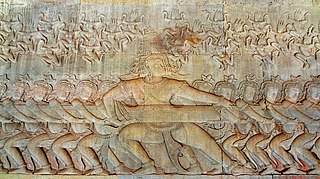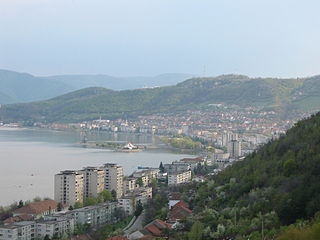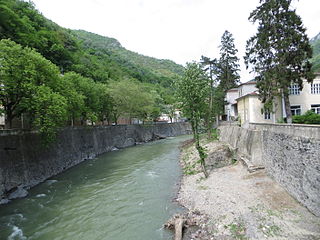
Asuras are a class of beings in Indian religions. They are described as power-seeking clans related to the more benevolent Devas in Hinduism. In its Buddhist context, the word is sometimes translated "titan", "demigod", or "antigod".

Mehedinți County is a county (județ) of Romania on the border with Serbia and Bulgaria. It is mostly located in the historical province of Oltenia, with one municipality (Orșova) and three communes located in the Banat. The county seat is Drobeta-Turnu Severin.

Orșova is a port city on the Danube river in southwestern Romania's Mehedinți County. It is one of four localities in the county located in the Banat historical region. It is situated just above the Iron Gates, on the spot where the Cerna River meets the Danube.

Deva means "heavenly, divine, anything of excellence", and is also one of the terms for a deity in Hinduism. Deva is a masculine term; the feminine equivalent is Devi.

An asura in Buddhism is a demigod or titan of the Kāmadhātu. They are described as having three heads with three faces each and either four or six arms.
The Kālakeyas or Kālakhañjas are a class of Asura in Buddhist and Hindu mythology. They were a powerful, ferocious and cruel clan of the Dānavas.

The Cerna is a river in Romania, a left tributary of the river Danube. The Cerna has its source on the south-east side of the Godeanu Mountains and flows into the Danube near the town Orșova. The upper reach of the river is sometimes called Cernișoara. With a length of 79 km (49 mi) and its basin of 1,380 km2 (530 sq mi), it carves an erosive tectonic valley with numerous gorges, quite deep sometimes. There is a man-made lake on it (Tierna), just before it crosses the Băile Herculane spa, to perpetuate the old toponimic od Dierna. The upper course of the Cerna is part of the Domogled-Valea Cernei National Park. The Cerna flows through the villages and towns Cerna-Sat, Țațu, Băile Herculane, Pecinișca, Bârza, Topleț, Coramnic and Orșova.

Asura is a genus of moths in the subfamily Arctiinae erected by Francis Walker in 1854.

The Treaty of Sistova ended the last Austro-Turkish war (1787–91). Brokered by Great Britain, Prussia and the Netherlands, it was signed in Sistova in Bulgaria on 4 August 1791. The treaty was written in French and Turkish.

SS Orsova was a steam ocean liner owned by the Orient Steam Navigation Company. She was built by John Brown & Company at Clydebank, Scotland in 1909 to operate a passenger service between London and Australia. Her maiden voyage was 25 June 1909.

SS Orsova, was a British ocean liner, built by Vickers Armstrong in Barrow-in-Furness, England for the Orient Steam Navigation Company for their Great Britain-to-Australia services via the Suez Canal. She was the final development of the 28,000 ton class which began with the SS Orcades of 1948 and continued with the SS Oronsay of 1951. In 1960, in conjunction with the introduction of the new larger and faster Oriana and Canberra, the fleets of Orient and P&O were combined as P&O-Orient Lines, although the Orient ships retained their corn-coloured hulls and sailed under their own house flag. In 1966, P&O acquired the balance of the Orient shares and the Orient Line was discontinued, with Orsova and her fleet mates being transferred to the ownership of the Peninsular & Oriental Steam Navigation Company (P&O), painted white and under the P&O houseflag.

Gurghiu is a commune in Mureș County, Transylvania, Romania. It is composed of ten villages: Adrian (Görgényadorján), Cașva (Kásva), Comori (Kincsesfő), Fundoaia (Kásvavölgy), Glăjărie (Görgényüvegcsűr), Gurghiu, Larga (Lárgatelep), Orșova (Görgényorsova), Orșova-Pădure (Szécs) and Păuloaia (Pálpatak).
The Port of Orșova is one of the largest Romanian river ports, located in the city of Orşova on the Danube River.

Asura's Wrath is an action video game developed by CyberConnect2 and published by Capcom. Asura's Wrath was first announced at the Tokyo Game Show in 2010, and was released worldwide in February 2012. The game is playable on PlayStation 3, Xbox 360, Xbox One & Xbox Series X/S via 360 backwards compatibility, and the PlayStation 4 and PC via PlayStation Now.
Asura strigipennis is a moth of the family Erebidae. It was described by Gottlieb August Wilhelm Herrich-Schäffer in 1914. It is found on Java, Sumatra and in China, Taiwan and India.
Asura quadrilineata is a moth of the family Erebidae. It is found on Aru and in Australia.

Cyme sexualis is a moth of the subfamily Arctiinae first described by Felder in 1864. It is found on Ambon, Sulawesi, the Dampier Archipelago. and in New Guinea.

The Orsova Offensive was a military engagement fought between the armies of Romania and Austria-Hungary at the start of the Romanian Campaign in August–September 1916. It ended in a Romanian victory which led to the Romanian occupation of the west bank of the Cserna (Cerna) River for over two months.

The Battle of Herkulesfürdő was a military engagement during the Romanian Campaign of World War I. It was fought between Romanian forces on one side and Central Powers forces on the other side. It resulted in a Romanian victory.
The First Battle of Orsova was a World War I military engagement between Austro-Hungarian and German forces on one side and Romanian forces on the other side. The Central Powers failed to advance, the battle thus resulting in a Romanian victory.














